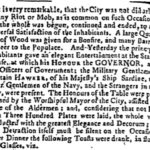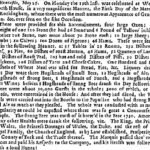A year ago, we read about certain Georgian era drinking habits of the early decades of the colony of Upper Canada – what is now Ontario. It includes my favorite observations included in Ontario Beer – in fact, one of my favorites in the entire history of drinking in Canada. It is from the events of 12 and, I suppose, 13 August 1827 at Guelph on the celebration of the King’s birthday:
…all sat down and enjoyed a hearty meal. “After the cloth was removed,” toasts were drunk to everybody and every conceivable thing, the liquors, of all imaginable descriptions, being passed round in buckets, from which each man helped himself by means of tin cups, about two hundred of which had been supplied for the occasion… those who remained continued to celebrate the day in an exceedingly hilarious manner, most of them, who had not succumbed to an overpowering somnolency, celebrating the night too, many of them being found next morning reposing on the ground in the market place, in loving proximity to the liquor pails, in which conveniently floated the tin cups…
A particular achievement in Pete Brown’s book on the history of the origins of IPA, the excellent Hops and Glory is how in contextualizing the history of the beer in the history of, you know, history – a rare enough thing in itself – he describes how the Georgians were quite unlike their grand-children, the Victorians. While they were cultural imperialists, they were not exactly racists. Leadership of the East India Company would intermarry into the royal classes of India just as how in mid-1700s upstate New York a man of the status of William Johnsonwould partner with a woman of the status of Molly Brant. We are in a sense as much or more the inheritors of Georgian free-spirited materialism as Victorian clenched paternalism. Maybe. One thing, however, we now definitely miss out on is the Georgian officially sanctioned staggeringly plastered public celebration.
 Consider the celebration described in the newspaper report from 26 May 1766 as set out in the New York Gazette. If you click on the image you will see a bigger image of the first paragraph. A pdf of the whole article is here. A great dinner is described celebrating the repeal of the Stamp Act, that most sensible piece of imperial legislation aimed at helping the American colonies pay the cost of their own protection. Ingrates. Anyway, after the dinner twenty-one
Consider the celebration described in the newspaper report from 26 May 1766 as set out in the New York Gazette. If you click on the image you will see a bigger image of the first paragraph. A pdf of the whole article is here. A great dinner is described celebrating the repeal of the Stamp Act, that most sensible piece of imperial legislation aimed at helping the American colonies pay the cost of their own protection. Ingrates. Anyway, after the dinner twenty-one
separate toasts were given. No wonder the article begins with the statement that the evening didn’t devolve into the riot and the mob “as is common on such Occasions“! My favorite toast is the fourth one: “may the illustrious house of Hanover preside over the United British Empire to the End of Time.” Not a long time. To the end of time. Such ingrates. The list is important in itself as it arises just before the interests leading to the Revolution are fully severed but what is also interesting is the last bit of the paragraph just below the toasts.
The Cannon belonging to the Province, being placed in the State-House Yard, the Royal Salute was fired on drinking the King, and Seven Guns after every succeeding Toast. The whole concluded in the Evening with Bonfires, Ringing of Bells, and Strong Beer to the Populace, and gave general Satisfaction to every Person concerned…
 How was riot avoided? Free smashings of strong beer to the populace? What a time! What a splendid form of government!! And it was not just at state events or events of general public importance. Click on that thumbnail to the left. It’s from the New York Gazette of 12 August 1751 but it describes a celebration of another sort of birthday in England, a twenty-first birthday party held on 25 May that year for the Marquis of Rockingham at Wentworth House in Yorkshire. I grew up in Nova Scotia – first made a British colony just two years before this celebration – where both Rockingham and Wentworth are place names. Look what happens at the party:
How was riot avoided? Free smashings of strong beer to the populace? What a time! What a splendid form of government!! And it was not just at state events or events of general public importance. Click on that thumbnail to the left. It’s from the New York Gazette of 12 August 1751 but it describes a celebration of another sort of birthday in England, a twenty-first birthday party held on 25 May that year for the Marquis of Rockingham at Wentworth House in Yorkshire. I grew up in Nova Scotia – first made a British colony just two years before this celebration – where both Rockingham and Wentworth are place names. Look what happens at the party:
Liquors drank that Day were three Hogsheads of Small Beer, 13 Hogsheads of Ale, 20 Hogsheads of Strong Beer, 8 Hogsheads of Punch, and 4 Hogsheads of Port Wine; besides 8 Hogsheads of strong Beer drank the Day following. There were 10,000 Guests in the whole; 3000 of which, or upwards, were entertained in the House; and after they had dined, the Victuals were carried out into the Booths to the Populace who had strong Beer and Ale much as they pleased… The strong Beer was most of it brewed in the Year 1730…
A few years ago, Martyn wrote about these coming of age, twenty-first birthday celebrations and their massive 21 year old beers brewed in the year of a child’s birth to celebrate their future adulthood. In fact when I came across this story I was just going to send it to him… until I read him “there is little or no evidence of 21-year-old ales before the 1770s or 1780s.”* It seems the news of these celebrations at Wentworth House for Charles Watson-Wentworth, 2nd Marquess of Rockingham** might represent a wee advance in brewing history. Maybe. Martyn might already know this. Probably does.
So there you are. Three mass gatherings of Georgians well prepared for and well able to meet the demands of massive public intoxications celebrating joy. I don’t think I could survive even a few hours of it. Damn Victorians.
*Being a wee bugger, I kept it for myself. Well, really, I kept it for this story. I would otherwise have sent it to Martyn, the very best sort of colleague in this beer writing game.
**A man who, if listened to, may have altered history to a greater degree.

[Original comments…]
Martyn Cornell – November 30, 2015 11:32 AM
http://zythophile.wordpress.com
I’m happy to say I came across the Marquess of Rockingham’s celebrations in time for the chapter on coming-of-age ales in Strange Tales of Ale. It does seem to be the earliest mention so far of very-long-aged-ale, though. Strangely I just came across a book written in 1765 which said that “in our fore-father’s time there has been beer brewed at the birth of the first child and kept until the wedding of that child” and complaining that “such an example is now scarcely to be found” – though coming-of-age ales were certainly being brewed then, and such brewings look to have increased over the next 40 or more years, though that may just be an artifact of the increasing number of newspapers being published …
Alan – November 30, 2015 8:21 PM
Yes, that’s a kicker isn’t it. The record is not the story just the recorded bit. I might have to see if there are 1600s diarists or great house ledgers on line.